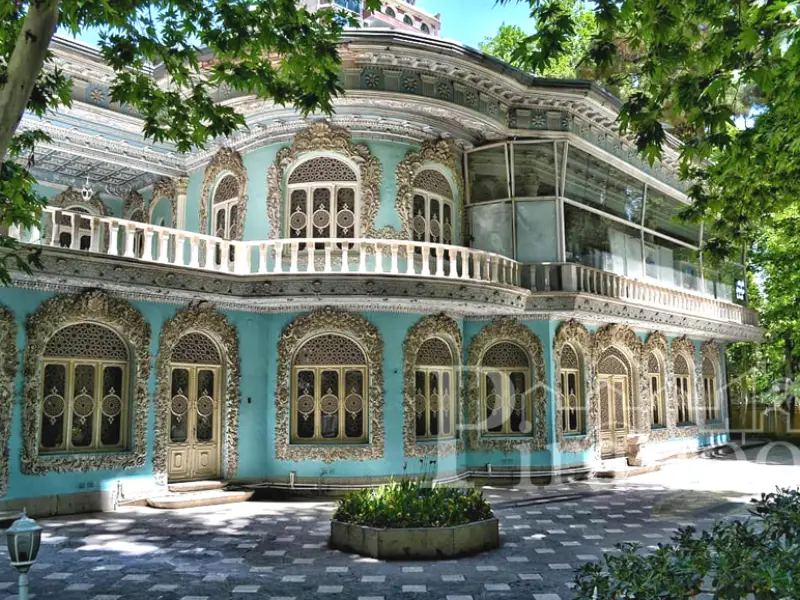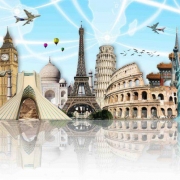Travel to Iran would probably be like none of your previous trips, it is certainly a unique destination you never expect. There are loads of unique experiences waiting for you here, including cultural attractions, natural beauty, warm-hearted hospitable people, and tasty local foods.
Well, the next issue might be your safety. While you are searching is it safe to travel to Iran, it is never easy to distinguish between propaganda and genuine information. The two risk assessment institutions “International SOS” and “Risk control” evaluate Iran’s risk to travelers to be comparable to that of most European countries’.
Iran Doostan Tours Co. is a reliable Iran travel agency for incoming tours to Iran. No difference whether you are aiming to travel to Iran from Canada or travel to Iran from India, or any other country, we are honored to offer high-quality services in terms of diverse package tours. As a tour operator and travel agency in Iran, we provide all travel services including itineraries, visa, tour guides, transportation, accommodation, and whatever our tourists may need while traveling to Iran. If you are looking for some self-drive tours like travel to Iran by car, we are also ready to provide you with all you may need.
It is good to know that the Iran visa process is quite fast and convenient and the tourists can also apply for a visa online. However, if you intend to travel to Iran from the UK or US, your visa may take a bit longer to be issued.
If you have a call for an independent traveling to Iran, we wholeheartedly respect your decision; then all you may need to have except an Iran travel guide book and a map would be reading some tips for traveling to Iran in our Iran travel blog. For any travel to Iran experience, you are recommended to visit our guest blog and also our trip advisor page, it may be helpful. You may also like to spare some time watching interesting Iran tourism videos to whet your appetite for traveling to Iran.
Our professional colleagues are ready to help you if you have planned to travel to our country. Contact us via info@idt.ir. We will be back to you soon.
Posts
Top 10 Garden Museums in Tehran (Photos, Timing)
Tehran is known as “the city of museums” among people. This bustling metropolis embraces picturesque historical garden museums as well. These amazing attractions combine history narrations with artistic creations to exhibit glorious history as well as man-made artifacts. Though the heavy traffic and crowded streets are sometimes annoying, garden museums in Tehran can provide you a peaceful relaxing atmosphere to escape the city chaos. Let’s explore the top 10 historical garden museums in Tehran you shouldn’t miss for an enjoyable visit and a memorable experience.
Golestan Palace
Golestan Palace Complex is the only UNESCO Heritage Site in the heart of Tehran. It sits in a region initially called Tehran Arg which was the city’s gateway in the Qajar period. The palace was established during the Safavid era. Zand dynasty renovated it. Then, the founder of the Qajar dynasty, Agha Mohammad Khan, selected the palace as the official residence of the Qajar dynasty (1794-1925). Moreover, it became the center of artistic creations. The palace complex is composed of seventeen palaces and halls of different ages surrounding a picturesque garden. Each building is a treasure of architecture, art, and decorative craftsmanship. Golestan Palace has witnessed some significant moments in Iran’s history such as the coronation of the Qajar and Pahlavi kings. Shams-ol Emareh, or the Sun Building, the first recreational tower of Tehran, is one of the valuable features of this palace complex. It enjoys a good view of the Tehran landscape from its rooftop. Takht-e Marmar Terrace (Marble Throne), Talar-e Ayeneh (Mirror Hall), Khalvat-e Karim Khani (Karim Khan Nook), and Emarat-e Badgir (the Wind Catcher) are among the prominent halls that should not be missed.
Opening hours:
Spring and summer: Every day from 9:30 a.m. to 18:30 p.m. except for public mourning holidays
Fall and winter: Every day from 9:00 a.m. to 16:30 p.m. except for public mourning holidays
Location: Click Here
Saadabad Palace
Saadabad Palace is a cultural and historical complex located in Shemiran, at the northernmost part of Tehran. Its lavish garden, covering an area of 110 hectares, embraces 18 palaces and galleries dating back to Qajar (19th century) and Pahlavi periods. The area was used as a summer palace for the Qajar royal family at first and later, as the summer residence of Pahlavi dynasty. It turned into the museum after the revolution in 1972. The Green Palace- the first palace built during Pahlavi period, the White Palace or Mellat Museum that is the largest mansion, the Black Palace (or Fine Arts Museum), the Military Museum, and the Dafine Museum (or Museum of Treasure) are just some of the remarkable palaces and museums for tours to Tehran. There is much more to see in the complex! After your visit, you can make your way to Tajrish Bazaar for shopping or to Darband for relaxing, drinking tea or eating traditional food in the cafes or restaurants settled along the river.
Opening hours: Every day from 9:00 a.m. to 18:45 p.m. except public mourning holidays (Last entry: 17:00)
Location: Click Here
Niavaran Palace
Niavaran Palace is a historical complex located in a landscaped garden in the north of Tehran. The complex traces its origin to the Qajar dynasty. It was used as the summer residence by the Qajar monarchs. The pavilions were added to the complex during the reign of different Qajar kings. Today, Niavaran Palace consists of five museums including Niavaran Palace (the primary residence of the last royal family), the private library containing about 23000 books, Ahmad Shahi Pavilion (built during the late Qajar era), Sahebqaraniyeh Palace, and Jahan Nama Museum. Some copies of inscriptions from ancient times of Persia are exhibited in the garden as well.
Opening hours:
Spring and summer: Every day from 9:00 a.m. to 18:00 p.m. except public mourning holidays
Fall and winter: Every day from 8:00 a.m. to 16:00 p.m. except public mourning holidays
Location: Click Here
Moghadam Museum
Moghadam Museum is one of the most precious museums in Tehran. The house dates back to the Qajar period. Mohsen Moghadam- one of the Iranian pioneers of archeology who inherited the house from his father- and his French wife dedicated life to collecting valuable historical objects from around the world. They bequeathed the family house with all its treasure to Tehran University.
Opening hours: Every day from 9:00 a.m. to 17 p.m. except Saturdays and public mourning holidays
Location: Click Here
Ferdows Garden
Baq-e Ferdows (literally the paradise) is a historical complex, covering 20 thousand square meters, in Tajrish in the north part of Tehran. It was called Ferdows since the beauty of its garden, pools, and fountains, as well as the splendid decorations of the mansion, replicated the beauty of heaven on earth. The complex was founded during the reign of Mohammad Shah Qajar (1808-1848). It was also used to be called Mohammadieh at that time. After the king’s death, the complex underwent alterations over the years. The two-floor mansion (the oldest part was completely destroyed) in the middle of the complex is applied as the Cinema Museum of Iran from 2002. It is decorated with patterned pillars and moldings. The museum exhibits photos, posters, and equipment of Iran’s movie industry. In fact, it presents and safeguards Iran’s cinema heritage. It is usually the host of different cultural events such as theater shows. The garden embraces two movie theaters, two cafeterias, and gift shops. Ferdows garden is close to the museums of Time and Music, as well as Imamzadeh Saleh.
Opening hours:
Every day from 9:00 a.m. to 19:00 p.m. except Fridays and public mourning holidays (Last entry: 18:15)
Location: Click Here
Negarestan Garden
This beautiful garden is located in the central part of Tehran. It was built in 1802 by the order of Fath Ali Shah- the second Qajar king- as a summer residence. The halls are ornamented with mirrors. Since the mansion was decorated by the most prominent painters’ works, it was named Negarestan, literally meaning a place encompassing many pictures. The museum in the garden exhibits the paintings of Kamal-ol Molk (1847-1940) – the leading Iranian artist- and a number of his students. Negarestan garden was turned into the school of fine arts by Kamal-ol Molk in 1911. In 1934, some parts of this historical garden were used by Tehran University to hold educational courses. Today, the garden has been changed into the museum of Tehran University’s history and glory. An open-air café in the garden offers the visitors refreshing drinks and a traditional menu in a pleasant environment. It takes only five minutes to walk from the Baharestan metro station to this beautiful garden. It is also very close to several museums and tourist sites such as the National Jewelry Museum, National Museum of Iran, cafes, and restaurants.
Opening hours:
Museums: Every day from 9:00 a.m. to 18:00 p.m. except Mondays and public mourning holidays
Garden: Every day from 9:00 a.m. to 22:00 p.m. except for public mourning holidays
Restaurant: Every day from 9:00 a.m. to 22:00 p.m. except for public mourning holidays
Location: Click Here
Masoudieh Palace
The five-hectare Masoudieh Palace (Emarat-e Masoudieh) is one of the most beautiful historic houses in the center of Tehran dating back to the Qajar period. Its beautiful Iranian-European architecture made this place a popular attraction for the residents as well as the tourists and travelers who wish to experience the Tehran city tour. The Divankhaneh palace is decorated with stucco, colored glasses, ceramics, gridded doors and windows, symmetrical floral patterns and geometrical motifs, calligraphy, and murals. The palace was built in 1878 by order of Naser al-Din Shah Qajar for his son Masoud Mirza- the governor of Isfahan. Over time, it was used for different cultural, historical, and political purposes: the main gathering center for the Iranian Constitutional Revolution (1905-1911), the first official library (1926), the national museum of Iran, and Ministry of Education (1967). There are two mansions, a restaurant, and an entrance hall in the complex. The restaurant, with a traditional design, serves traditional food and drinks in a cozy environment. Some cultural classes and galleries are held in this historical mansion on different occasions throughout the year.
Opening hours: Every day from 9:00 a.m. to 16:00 p.m. except on public holidays
Location: Click Here

The five-hectare Masoudieh Palace (Emarat-e Masoudieh) is one of the most beautiful historic houses in the center of Tehran
Time Museum
Time Museum was inaugurated in 1999. The two-story mansion, dating back to the Qajar era, is a mixture of architecture, amazing plaster works, and tile works. Outdoors, the visitors can see some models of old sundials, clepsydras, hourglasses, and the like some going back to 5000 years ago. The first floor exhibits the evolution of clocks from the seventeenth century to the present. Different kinds of clocks- pendulum, wall, floor, mantel and tabletop, bracket, cuckoo, chime shut off, musical, atomic, etc. – ornamented with sculpture, enamel, and mosaic have been presented by other countries to Iran. The first Iranian-made clock is kept here too. The second floor displays the prominent political, historical, and scientific characters’ watches, as well as other kinds of clocks such as marine, and military clocks. The evolution of time measurement tools, mechanical clocks and watches, and some fossils from different geological periods are exhibited on this floor as well. The walls of the museum show the documents on the Iranian calendar. There is a café in the garden where you can relax and refresh. Its breakfast is popular among visitors. It is close to a number of attractions such as Saadabad palace, Niavaran palace, Tajrish traditional bazaar, and Cinema museum in Ferdows garden.
Opening hours: Every day from 9:00 to 18:30 from Saturdays to Wednesdays and from 10:00 to 18:30 on Thursdays and Fridays except national holidays
Location: Click Here
Iranian Art Museum Garden
Though the Museum Garden of Iranian Arts (or Bagh-e Honar-e Irani) is not a historical site, it contains replicas of twelve Iranian historical buildings and monuments in miniature size. The small models of prominent tourist sites, made by Italian artists in the Pahlavi period, such as Tehran’s Azadi Tower, Zanjan’s Soltaniyeh Dome, Kashan’s Fin Garden, Shiraz’s Naqsh-e Rustam, Urmia’s St. Thaddeus Monastery, and Isfahan’s Chehel Sotoun are scattered in the beautiful garden surrounded by handicraft shops, a bookstore, a restaurant, and a cafe. Here’s a nice spot for walking, shopping, eating, relaxing, and mingling with locals. Moreover, art exhibitions and workshops are sometimes held here. The garden and its mansion were built in 1932 but opened as a museum in 2008. It covers the nearly one-hectare area in Elahieh near Tajrish square in the north part of Tehran.
Opening hours: Every day from 9:00 a.m. to 21:30 p.m. except for public mourning holidays
Location: Click Here
Tehran’s Persian Garden
Persian or Iranian Garden (or Baq-e Irani) is located in an old neighborhood known as Vanak Village (Deh Vanak) in northwest Tehran. Though it is not that much big, you can spend some peaceful moments there in the chaotic city of Tehran. It is also very convenient. This beautiful garden follows the amazing pattern of Persian Gardens’ architecture and design in ancient Persia. The brooks are flowing around and the tiny fountains are scattered along the way in the garden. Due to the beautiful tulips, the garden is scenic, especially in the springs. The building in garden was built in the traditional Persian style. It is decorated with colorful latticed windows.
Location: Click Here
Are you planning to travel to Iran? Check out our Iran tours.
iran visa for chinese: Iran Waives Visa For Chinese Tourists
Chinese tourists will no longer require a visa to travel to Iran. Iran’s government has approved a visa waiver program for Chinese tourists. According to Vali Teymouri, the deputy head of Iran’s Cultural Heritage, Handicrafts and Tourism Organization (ICHHTO), the decision was made by President Hassan Rouhani’s cabinet and it will be announced officially after due process.
The authorities in the Islamic Republic of Iran have decided to abolish entry visa to Iran unilaterally for Chinese nationals with the purpose of attracting more Chinese tourists to the country.
Iran’s Tourism officials have been trying to take some similar measures to boost the tourism sector to increase revenues under U.S. sanctions. For example, Iran announced earlier that the foreign tourists’ passports will no longer be stamped to skip the U.S. travel ban.
Contrary to all sanctions, ancient Iran witnessed considerable growth in tourist arrivals in the last fiscal year (ended March 20, 2019) comparing the preceding year.
Are you planning to travel to Iran? Check out our Iran tours.
World Heritage Day
World Heritage Day
April 18th is celebrated annually around the world to preserve and promote cultural heritage sites. World Heritage Day, or The International Day for Monuments and Sites, is a day for all humans to remember the main role of cultural sites in understanding who they are or where they come from, and how important is to preserve and protect the world’s cultures. It aims to raise global awareness about the diversity and vulnerability of cultural heritage sites, the challenges for their conservation, the demand for international efforts to protect and preserve these invaluable heritages, as well as the benefits these efforts provide for communities.
The International Day for Monument and Sites was established on 18 April 1982 by the International Council for Monuments and Sites (ICOMOS) and approved by the General Assembly of UNESCO in 1983. Regarding the importance of protecting the invaluable cultural heritage sites and monuments, the organization gathers together different experts in related fields such as architecture, geography, archeology, engineering, etc. each year. Conferences, lectures, seminars, workshops, roundtable discussions, interviews, articles in newspapers and magazines, publications, photo exhibitions, banners, and posters, awarding prizes to the people or organizations who have played an outstanding role in the conservation of cultural heritage, and visits to heritage sites and monuments are of the activities.
Every year, a theme is proposed by the ICOMOS. For example, the theme was “Heritage for Generations” in 2018. The 2019 theme is “Rural Landscapes”.
Today, the organization has nearly 10000 members in over 150 countries around the globe. They are devoted to ensuring the most important cultural sites are preserved well for future generations. Moreover, they make an attempt to identify new exceptional historical and archeological heritage sites worldwide that should be preserved for future generations. For example, Persian Qanat in Iran was added to the list in 2016.
Many of the heritage sites offer free admission on this day. Then, just do your part to preserve the World Cultural Sites for future generations by paying a visit to the cultural sites near you. Respect the sites and monuments during your visit, and consider submitting the sites to ICOMOS, if they are worth being preserved but have not been yet.
Are you planning to travel to Iran? Check out Iran heritage tour.


















